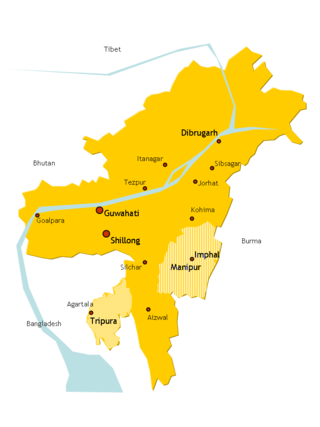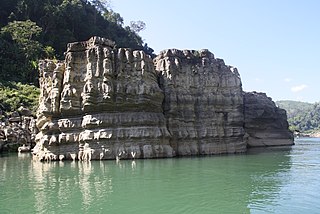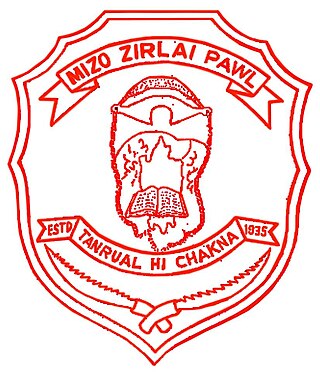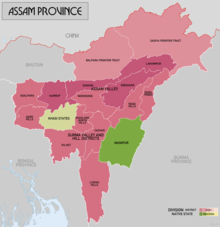
Mizoram is a landlocked state in northeast India, with Aizawl as its seat of government and largest city. Within India's northeast region, it is the southernmost state, sharing borders with three of the Seven Sister States, namely Tripura, Assam and Manipur, and also shares a 722-kilometre (449 mi) border with the neighbouring countries of Bangladesh and Myanmar. The state spans over an area of approximately 21,087 square kilometres, of which approximately 91% is forested. With an estimated population of 1.25 million in 2023, it is the second least populous state in the country.
Mizo Union was the first political party in Mizoram, northeast India. It was founded on 6 April 1946 at Aizawl as the Mizo Common People's Union. At the time of independence of India from the british rule in india in 1947, the party was the only political force in the Lushai Hills. It won the first Mizoram District Council general election under the new Indian Union in 1951, and consecutively in 1957, 1962 and 1966.
The Mizo National Front is a regional political party in Mizoram, India. MNF emerged from the Mizo National Famine Front, which was formed by Pu Laldenga to protest against the inaction of the Government of India towards the famine situation in the Mizo areas of the Assam state in 1959. It staged a major uprising in 1966, followed by years of underground activities. In 1986, it signed the Mizoram Accord with the Government of India, renouncing secession and violence. The MNF then began contesting elections and has formed state government in Mizoram three times. It is currently the state's opposition party, with its president, Zoramthanga, as the Former Chief Minister of Mizoram.
The Hmar language belongs to the Mizo language branch of the Sino-Tibetan family of languages. The speakers of this language use Mizo language as their second language (L2).

The Mizo people, historically recorded as the Lushais, are an ethnic group native to the state of Mizoram in India and neighbouring states of Northeast India. They speak the Tibeto-Burman language of Mizo, the official language and lingua franca of Mizoram. The state is the second most literate state in India, at more than a rate of 90%.

The history of Mizoram encompasses the history of Mizoram which lies in the southernmost part of northeast India. It is a conglomerate history of several ethnic groups of Chin people who migrated from Chin State of Burma. But information of their patterns of westward migration are based on oral history and archaeological inferences, hence nothing definite can be said. The recorded history started relatively recently around the mid-19th century when the adjoining regions were occupied by the British monarchy. Following religious, political and cultural revolutions in the mid-20th century majority of the people agglomerated into a super tribe, Mizo. Hence the officially recognised settlement of the Mizos became Mizoram.

Lunglei, formerly known as Lungleh, is the second-largest town in Mizoram, northeastern India, situated in the south-central part of the state. The town served as the capital of British Mizoram from 1889 to 1898. It is situated 729 metres above sea level and is situated on a ridge surrounded by hills. Lunglei has an estimated population of 80,000 residents as of 2023.
Champhai is the third largest town in Mizoram, northeast India and is one of the oldest settlements founded by the Mizo people, that initially served as a capital for the Hmar dynasty. Located near the India–Myanmar border facilitates cross-border trade, it serves as a hub for trade and commerce in the region.
Laldenga was a Mizo separatist and politician from Mizoram in northeast India. He was the founder of the Mizo National Front, a social organisation turned political party. He was the first Chief Minister of Mizoram as a federated state, the office of which he held from 1986 to 1988.

Lunglei district is one of the eleven districts of Mizoram state in India. As of 2011 it is the second most populous district in the state, after Aizawl.

Lawngtlai district is one of the eleven districts of Mizoram state in India.

The Mizo National Front uprising was a revolt against the government of India aimed at establishing a sovereign nation state for the Mizo people, which started on 28 February 1966. On 1 March 1966, the Mizo National Front (MNF) made a declaration of independence, after launching coordinated attacks on the Government offices and security forces post in different parts of the Mizo district in Assam. The government retaliated and recaptured all the places seized by the MNF by 25 March 1966.

Mizo Zirlai Pawl is a Mizo multinational student organization and apex students body in Mizoram state. Established on 27 October 1935 in Shillong by Mizo earlier educated students. Originally as the Lushai Students Association (LSA), which was later replaced with the "Mizo Zirlai Pawl" on 1 September 1946. As Mizoram State government notified MZP raising day 27 October was observed as "Zirlaite Ni" from 2008 in Mizoram. It was registered as SR No. 35 of 1969–70 under Indian Societies Registration Act. Its general headquarters is in the state capital of Mizoram, Aizawl. And it has 12 headquarters inside and outside of Mizoram state, such as Churachandpur, Behliangchhip, and in Mizoram state - Serchhip, Biate, Champhai, Darlawn, Kolasib, Mamit, Zawlnuam, Saitual, Lunglei and Khawzawl. It has 50 Sub-Headquarters and many branches.

Education in Mizoram consists of a diverse array of formal education systems ranging from elementary to university, from training institution to technical courses. The Government of India imposes mandatory education at least up to the basic level. For this public schools are made free of fees, and provided with free textbooks and school lunch.

The history of Christianity in Mizoram covers the origin and development of all forms of Christianity in Mizoram since the British occupation at the end of the 19th century. Christianity arrived as a consequence of tribal warfare, raids of British plantations, and the ensuing punitive British military expedition called the Lushai Expedition of 1871. The subsequent annexation of the erstwhile Lushai Hills to the British Empire opened the gateway for British Christian missions to evangelise the Mizo people.

Phullen is a town in Saitual district, in the Indian state of Mizoram. As per the Constitution of India and Panchayati Raj Act, Phullen is administrated by a Village Council who are the elected representatives of the village. It is located 125 kilometres (78 mi) east of the State Capital Aizawl, which is also the capital of Mizoram. Phullen is a Block headquarters of Phullen Block, which is bounded by Darlawn Block towards west, Ngopa Block towards East, Thingsulthliah Block
The Mizoram Peace Accord, 1986 was an official agreement between the Government of India and the Mizo National Front (MNF) to end insurgency and violence in Mizoram, India, that started in 1966. The Mizo National Front was an organisation of Mizo secessionists led by Laldenga to fight for independence from India. The movement was basically due to lack of support from the government during the great famine in Mizoram in the late 1950s. Political insurgency and social unrest ensued in the next decades. After a number of negotiations, the document titled Mizoram Accord, 1986: Memorandum of Settlement was finally signed on 30 June 1986. It was signed by Laldenga for MNF, R.D. Pradhan, Home Secretary, Government of India, and Lalkhama, Chief Secretary, Government of Mizoram. It is remarked as the most and only successful peace agreement in India after its independence from British Empire in 1947.

Aizawl, formerly known as Aijal, is the capital city and the most populous city of Mizoram, India. It is also the third largest city in northeast India, after Guwahati and Agartala. It is situated atop a series of ridges, with an average elevation of around 1,132 metres above sea level. In 2024, the city has an estimated population of 405,000 people.

British rule in the Lushai Hills, spanning from the late 1889 to the 1947, commenced with the Chin-Lushai Expedition of 1889-90 leading to the formal establishment of the two administrative districts in 1889 and continued through the integration of the regions into the province of Assam with both districts being merged as the Lushai Hills until India gained independence in 1947.

The Union Territory of Mizoram, spanning from 1972 to 1987, was formed as a response to the Mizo people's demand for greater autonomy. During this time period, reforms in administration and preservation of Mizo culture started.













